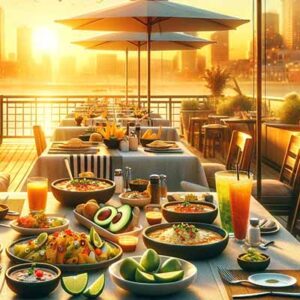The Many Types of Japanese Noodles: Udon, Soba, and Others - Henderson Edition
2024.8.17
by Min Kim
Japanese Cuisine
Japanese cuisine is marked by the harmony of taste, consistency, and appearance which defines its variety of dishes, reflecting the rich cultural style to which this country has been a witness. Among these, noodles occupy an extraordinary place, with Udon, Soba, and Ramen dominating the culinary landscape jointly. This article shall explore the diversity of Japanese noodles, including their history, preparation, and cultural relevance.
Udon: The Fat Wheat Noodle
It is a type of thick noodle, basically made of wheat flour, which originated in the Kansai region. The date of its origin could be as long as over a thousand years ago, with various theories referring to Chinese and Buddhist monk origins. Udon noodles have this unique kind of chew which provides a nice feel in the mouth, ready to give comfort and be filling.
Udon is served either hot or cold, and in quite a few different manners. A simple dish, Kake Udon, featuring noodles in a soy based broth, will illustrate the noodle’s texture and subtle flavor. Other popular variations include Tempura Udon, topped with crispy tempura, and Yaki Udon, where the noodles are stir fried with vegetables and meat.

Soba: The Buckwheat Noodle
Soba is thin noodles made from buckwheat flour and comes from the mountainous areas of Japan where the plant grows. It’s history is long as Udon’s, and Soba has been a traditional food since the Edo period in Japanese cuisine.
Soba has an earthy flavor and a smooth texture makes it a favorite both in Japanese and foreign diners. Similar to Udon, the style Soba can be either hot or cold. Zaru Soba, which literally means ‘chilled noodles served with a dipping sauce,’ is a popular summer dish. In winter, hot Soba in a tasty broth nourishes and warms the system.
Ramen: The Chinese Inspired Noodle
While Ramen represents thin wheat noodles served in a meat or fish based broth, it is rather a recent addition to Japanese cuisine, introduced from China in the late 19th century. Foreign by origin, it has been adopted and adapted by the Japanese to become a dish essentially Japanese.
Ramen is known for its rich umami packed broth and various toppings like sliced pork, green onions, and boiled eggs. From the North, there is Sapporo Ramen with miso based broth; then to the South, it is characterized by Hakata Ramen with a pork bone broth.
Other Notable Noodles:
Beyond Udon, Soba, and Ramen are other key noodles which comprise Japanese cuisine. There is Somen, the thin wheat noodles normally served cold and great for hot summer months. Shirataki is translucent noodles made from konjac yam and preferred for their very low calorie count. Last on the list is Yakisoba, although literally translated not really Ramen, more stir fried with meat and vegetables like Ramen, the mainstay at festivals and street food stalls.
Noodles have an extremely important place in Japanese culture and are linked with various customs and traditions. For instance, Toshikoshi Soba, literally ‘year crossing noodles’, eaten on the eve of New Year’s Day, is a pointer to longevity and cutting off of old year’s hardships. Similarly, eating of Somen during summer festivals is like a communal exercise which brings families and communities together.
Japanese noodles are the reflection of geographical diversities and the history Japanese cuisine was subjected to. Several textures, tastes, and ways of cooking them imply, so for each kind of noodle, it will be another culinary experience, tasting the rich style which Japanese food culture is.
As we continue to eat our way across the globe, it is a useful reminder there is a story behind each dish. The story of Japanese noodles speaks of adaptation and innovation, tradition, and regional pride. Next time you slurp down a steaming bowl of Udon, Soba, or Ramen, spare a thought for the humble noodle’s journey to your table from its very origins.
1stHendersonGuide.com

We List Only the Best
1st Henderson Guide is not a list of every business. Our website highlights only the best businesses / places / events are featured within these pages. This makes Henderson even more magical for residents and visitors alike.

Advertise Your Company
You can be seen by a high quality audience when you place an advertisement on 1st Henderson Guide. Not all companies are accepted… Call 702-445-9488 to be have your company seen by affluent buyers. You will be amazed how with the low price.

1st City Guide Expansion
1stCityGuide.com is the parent company of 225+ city guides worldwide. We are expanding and looking for Licensee partners to work together and provide a quality income when sharing the secrets of great cities around the world with visitors and residents alike. Call 702-210-4201 to discuss pricing and city guide availabilities.
